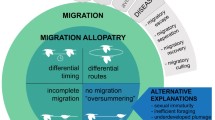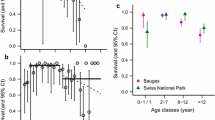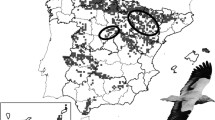Abstract
Studies of population dynamics of long-lived species have generally focused on adult survival because population growth should be most sensitive to this parameter. However, actual variations in population size can often be driven by other demographic parameters, such as juvenile survival, when they show high temporal variability. We used capture–recapture data from a long-term study of a hunted, migratory species, the greater snow goose (Chen caerulescens atlantica), to assess temporal variability in first-year survival and the relative importance of natural and hunting mortality. We also conducted a parasite-removal experiment to determine the effect of internal parasites and body condition on temporal variation in juvenile survival. We found that juvenile survival showed a higher temporal variability than adult survival and that natural mortality was more important than hunting mortality, unlike in adults. Parasite removal increased first-year survival and reduced its annual variability in females only. Body condition at fledging was also positively correlated with first-year survival in treated females. With reduced parasite load, females, which are thought to invest more in their immune system than males according to Bateman’s principle, could probably reallocate more energy to growth than males, leading to a higher survival. Treated birds also had a higher survival than control ones during their second year, suggesting a developmental effect that manifested later in life. Our study shows that natural factors such as internal parasites may be a major source of variation in juvenile survival of a long-lived, migratory bird, which has implications for its population dynamics.




Similar content being viewed by others
References
Alisauskas RT, Drake KL, Slattery SM, Kellett DK (2006) Neckbands, harvest, and survival of Ross’s geese from Canada’s Central Arctic. J Wildl Manage 70:89–100
Amundson CL, Arnold TW (2010) Anthelmintics increase survival of American coot (Fulica americana) chicks. Auk 127:653–659. doi:10.1525/auk.2010.09162
Anderson MG, Lindberg MS, Emery RB (2001) Probability of survival and breeding for juvenile female canvasbacks. J Wildl Manage 65:385–397
Arlettaz R, Schaad M, Reichlin TS, Schaub M (2010) Impact of weather and climate variation on hoopoe reproductive ecology and population growth. J Ornithol 151:889–899. doi:10.1007/s10336-010-0527-7
Bateman AJ (1948) Intra-sexual selection in Drosophila. Heredity 2:349–368. doi:10.1038/hdy.1948.21
Benton TG, Plaistow SJ, Coulson TN (2006) Complex population dynamics and complex causation: devils, details and demography. Proc R Soc B Biol Sci 273:1173–1181. doi:10.1098/rspb.2006.3495
Bogdanova MI, Nager RG, Monaghan P (2007) Age of the incubating parents affects nestling survival: an experimental study of the herring gull Larus argentatus. J Avian Biol 38:83–93
Braasch A, Schauroth C, Becker PH (2009) Post-fledging body mass as a determinant of subadult survival in common terns Sterna hirundo. J Ornithol p 150. doi:10.1007/s10336-008-0362-2
Bradley JS, Wooler RD (1991) Philopatry and age of first-breeding in long-lived birds. Acta XX Congr Int Ornithol 1657–1665
Brown CR, Brown MB (2004) Group size and ectoparasitism affect daily survival probability in a colonial bird. Behav Ecol Sociobiol 56:498–511. doi:10.1007/s00265-004-0813-6
Burnham KP, Anderson DA (2002) Model selection and multimodel inference: a practical information-theoretic approach, 2nd edn. Springer, New York
Calvert AM, Gauthier G (2005) Effects of exceptional conservation measures on survival and seasonal hunting mortality in greater snow geese. J Appl Ecol 42:442–452. doi:10.1111/j.1365-2664.2005.01042.x
Cam E, Aubry L (2011) Early development, recruitment and life history trajectory in long-lived birds. J Ornithol 152:187–201. doi:10.1007/s10336-011-0707-0
Cattadori IM, Haydon DT, Hudson PJ (2005) Parasites and climate synchronize red grouse populations. Nature 433:737–741. doi:10.1038/nature03276
Choquet R, Lebreton JD, Gimenez O, Reboulet AM, Pradel R (2009a) U-CARE: utilities for performing goodness of fit tests and manipulating CApture-REcapture data. Ecography 32:1071–1074. doi:10.1111/j.1600-0587.2009.05968.x
Choquet R, Rouan L, Pradel R (2009b) Program E-Surge: a software application for fitting multievent models. In: Thomson DL, Cooch EG, Conroy MJ (eds) Modeling demographic processes in marked populations, vol 3. Springer, New York, pp 845–865. doi:10.1007/978-0-387-78151-8_39
Clobert J, Lebreton JD (1991) Estimation of demographic parameters in birds population. In: Perrins CM, Lebreton J-D, Hirons GJM (eds) Oxford University Press, Oxford, pp 75–104
Cooch EG (2002) Fledging size and survival in snow geese: timing is everything (or is it?). J Appl Stat 29:143–162
Coulson T, Gaillard JM, Festa-Bianchet M (2005) Decomposing the variation in population growth into contributions from multiple demographic rates. J Anim Ecol 74:789–801. doi:10.1111/j.1365-2656.2005.00975.x
Croxall JP, Rothery P (1991) Population regulation of seabirds: implications of their demography for conservation. In: Perrins CM, Lebreton J-D, Hirons GJM (eds) Bird population studies. Oxford University Press, Oxford, pp 272–296
de Kroon H, Van Groenendael J, Ehrlen J (2000) Elasticities: a review of methods and model limitations. Ecology 81:607–618
Dickey MH, Gauthier G, Cadieux MC (2008) Climatic effects on the breeding phenology and reproductive success of an arctic-nesting goose species. Glob Change Biol 14:1973–1985. doi:10.1111/j.1365-2486.2008.01622.x
Folstad I, Karter AJ (1992) Parasites, bright males, and the immunocompetence handicap. Am Nat 139:603–622. doi:10.1086/285346
Francis CM, Richards MH, Cooke F, Rockwell RF (1992) Long-term changes in survival rates of lesser snow geese. Ecology 73:1346–1362. doi:10.2307/1940681
Frederiksen M, Bregnballe T (2000) Diagnosing a decline in return rate of 1-year-old cormorants: mortality, emigration or delayed return? J Anim Ecol 69:753–761
Gaillard JM, Yoccoz NG (2003) Temporal variation in survivals in mammals: a case of environment canalization? Ecology 84:3294–3306
Gaillard JM, Festa-Bianchet M, Yoccoz NG (1998) Population dynamics of large herbivores: variable recruitment with constant adult survival. Trends Ecol Evol 13:58–63
Gaillard JM, Festa-Bianchet M, Yoccoz NG, Loison A, Toïgo C (2000) Temporal variation in fitness components and population dynamics of large herbivores. Annu Rev Ecol Syst 31:367–393
Gauthier G, Brault S (1998) Population model of the greater snow goose: projected impacts of reduction in survival on population growth rate. In: Batt BDJ (ed) The greater snow goose: report of the Arctic Goose Habitat Working Group. Arctic Goose Joint Venture special publication. U.S. Fish and Wildlife Service, Washington and Canadian Wildlife Service, Ottawa, pp 65–80
Gauthier G, Lebreton JD (2008) Analysis of band-recovery data in a multistate capture-recapture framework. Can J Zool 36:59–73
Gauthier G, Giroux JF, Reed A, Béchet A, Belanger L (2005) Interactions between land use, habitat use, and population increase in greater snow geese: what are the consequences for natural wetlands? Glob Change Biol 11:856–868. doi:10.1111/j.1365-2486.2005.00944.x
Gauthier G, Fournier F, Larochelle J (2006) The effect of environmental conditions on early growth in geese. Acta Zool Sin 52(Supplement):670–674
Gibson G, Wagner G (2000) Canalization in evolutionary genetics: a stabilizing theory? BioEssays 22:372–380
Giroux JF, Batt B, Brault S, Costanzo G, Filion B, Gauthier G, Luszcz D, Reed A (1998) Conclusions and management recommendations. In: Batt B (ed) The greater snow goose, report of the Arctic Goose Habitat Working Group. U.S. Fish and Wildlife Service, Washington, D.C. and Canadian Wildlife Service, Ottawa, Ontario, pp 81–88
Harris MP, Frederiksen M, Wanless S (2007) Within- and between-year variation in the juvenile survival of common guillemots Uria aalge. Ibis 149:472–481
Hudson PJ, Dobson AP, Newborn D (1998) Prevention of population cycles by parasite removal. Science 282:2256–2258. doi:10.1126/science.282.5397.2256
Jenouvrier S, Barbraud C, Weimerskirch H (2005) Long-term contrasted responses to climate of two Antarctic seabird species. Ecology 86:2889–2903
Juillet C, Choquet R, Gauthier G, Pradel R (2012) Carry-over effects of spring hunt and climate on recruitment to the natal colony in a migratory species. J Appl Ecol 49:1237–1246. doi:10.1111/j.1365-2664.2012.02199.x
Le Galliard JF, Marquis O, Massot M (2010) Cohort variation, climate effects and population dynamics in a short-lived lizard. J Anim Ecol 79:1296–1307. doi:10.1111/j.1365-2656.2010.01732.x
Lebreton JD, Pradel R (2002) Multistate recapture models: modelling incomplete individual histories. J Appl Stat 29:353–369
Lebreton JD, Nichols JD, Barker RJ, Pradel R, Spendelow JA (2009) Modeling individual animal histories with multistate capture–recapture models. Adv Ecol Res 41:87–173. doi:10.1016/s0065-2504(09)00403-6
Legendre P (2011) Package lmodel2: model II regression
Lepage D, Gauthier G, Reed A (1998) Seasonal variation in growth of greater snow goose goslings: the role of food supply. Oecologia 114:226–235
Lesage L, Gauthier G (1997) Growth and organ development in greater snow goose goslings. Auk 114:229–241
Lindström J (1999) Early development and fitness in birds and mammals. Trends Ecol Evol 14:343–348
McLaughlin JD, McGurk BP (1987) An analysis of gizzard worm infections in fall migrant ducks at Delta, Manitoba, Canada. Can J Zool 65:1470–1477
Menu S, Gauthier G, Reed A (2002) Changes in survival rates and population dynamics of greater snow geese over a 30-year period: implications for hunting regulations. J Appl Ecol 39:91–102
Menu S, Gauthier G, Reed A (2005) Survival of young greater snow geese (Chen caerulescens atlantica) during fall migration. Auk 122:479–496
Monticelli D, Ramos JA, Hines JE, Nichols JD, Spendelow JA (2008) Juvenile survival in a tropical population of roseate terns: interannual variation and effect of tick parasitism. Mar Ecol Prog Ser 365:277–287. doi:10.3354/meps07508
Morris WF, Doak DF (2004) Buffering of life histories against environmental stochasticity: accounting for a spurious correlation between the variabilities of vital rates and their contributions to fitness. Am Nat 163:579–590
Morrison RIG, Davidson NC, Wilson JR (2007) Survival of the fattest: body stores on migration and survival in red knots Calidris canutus islandica. J Avian Biol 38:479–487. doi:10.1111/j.2007.0908-8857.03934.x
Naef-Daenzer B, Widmer F, Nuber M (2001) Differential post-fledging survival of great and coal tits in relation to their condition and fledging date. J Anim Ecol 70:730–738
Newborn D, Foster R (2002) Control of parasite burdens in wild red grouse Lagopus lagopus scoticus through the indirect application of anthelmintics. J Appl Ecol 39:909–914
Nunn CL, Lindenfors P, Pursall ER, Rolff J (2009) On sexual dimorphism in immune function. Philos Trans R Soc B Biol Sci 364:61–69. doi:10.1098/rstb.2008.0148
O’Neal DM, Kiley RP, Ketterson ED (2011) The effect of winter sex ratio on immune function and condition in a differential migrant. Physiol Behav 102:406–413. doi:10.1016/j.physbeh.2010.11.034
Pedersen AB, Greives TJ (2008) The interaction of parasites and resources cause crashes in a wild mouse population. J Anim Ecol 77:370–377. doi:10.1111/j.1365-2656.2007.01321.x
Peig J, Green AJ (2009) New perspectives for estimating body condition from mass/length data: the scaled mass index as an alternative method. Oikos 118:1883–1891. doi:10.1111/j.1600-0706.2009.17643.x
Pfister CA (1998) Patterns of variance in stage-structured populations: evolutionary predictions and ecological implications. Proc Natl Acad Sci USA 95:213–218
R Development Core Team (2010) R: a language and environment for statistical computing. R Foundation for Statistical Computing, Vienna
Redpath SM, Mougeot F, Leckie FM, Elston DA, Hudson PJ (2006) Testing the role of parasites in driving the cyclic population dynamics of a gamebird. Ecol Lett 9:410–418. doi:10.1111/j.1461-0248.2006.00895.x
Reed ET, Gauthier G, Pradel R (2005) Effects of neck bands on reproduction and survival of female greater snow geese. J Wildl Manage 69:91–100
Righi M, Gauthier G (2002) Natural infection by intestinal cestodes: variability and effect on growth in greater snow goose goslings (Chen caerulescens atlantica). Can J Zool 80:1077–1083
Rolff J (2002) Bateman’s principle and immunity. Proc R Soc London Ser B Biol Sci 269:867–872. doi:10.1098/rspb.2002.1959
Roth O, Scharsack JP, Keller I, Reusch TBH (2011) Bateman’s principle and immunity in a sex-role reversed pipefish. J Evol Biol 24:1410–1420. doi:10.1111/j.1420-9101.2011.02273.x
Saether BE, Bakke O (2000) Avian life history variation and contribution of demographic traits to the population growth rate. Ecology 81:642–653
Schmutz JA (1993) Survival and pre-fledging body-mass in juvenile emperor geese. Condor 95:222–225. doi:10.2307/1369404
Schmutz JA, Ely CR (1999) Survival of greater white-fronted geese: effects of year, season, sex, and body condition. J Wildl Manage 63:1239–1249
Sedinger JS, Nicolai CA (2011) Recent trends in first-year survival for black brant breeding in Southwestern Alaska. Condor 113:511–517. doi:10.1525/cond.2011.100218
Sedinger JS, Flint PL, Lindberg MS (1995) Environmental Influence on life-history traits—growth, survival, and fecundity in black brant (Brant bernicla). Ecology 76:2404–2414. doi:10.2307/2265816
Sedinger JS, Herzog MP, Ward DH (2004) Early environment and recruitment of black brant (Branta bernicla nigricans) into the breeding population. Auk 121:68–73. doi:10.1642/0004-8038(2004)121[0068:eearob]2.0.co;2
Shutler D, Alisauskas RT, Daniel McLaughlin J (2012) Associations between body composition and helminths of lesser snow geese during winter and spring migration. Int J Parasitol 42:755–760. doi:10.1016/j.ijpara.2012.05.008
Slattery SM (2000) Factors affecting first-year survival in Ross’ Geese. University of Saskatchewan
Slattery SM, Alisauskas RT (2002) Use of the Barker model in an experiment examining covariate effects on first-year survival in Ross’s Geese (Chen rossii): a case study. J Appl Stat 29:497–508
Taber RD (1971) Criteria of sex and age. In: Giles RH Jr (ed) Wildlife management techniques. The Wildlife Society, Washington, DC, pp 325–402
Toïgo C, Gaillard JM (2003) Causes of sex-biased adult survival in ungulates: sexual size dimorphism, mating tactic or environment harshness? Oikos 101:376–384
van de Pol M, Vindenes Y, Saether BE, Engen S, Ens BJ, Oosterbeek K, Tinbergen JM (2010) Effects of climate change and variability on population dynamics in a long-lived shorebird. Ecology 91:1192–1204
Acknowledgments
Funding was provided by the Natural Sciences and Engineering Research Council of Canada, the Arctic Goose Joint Venture (Canadian Wildlife Service), the Centre d’Étude Nordiques, the Department of Indian and Northern Affairs Canada and by the International Research Group Dynamics of Biodiversity and Life-History traits. Logistic support in the Arctic was generously provided by the Polar Continental Shelf Project (Natural Resources Canada) and assistance in the field by Parks Canada and the Hunter and Trappers Association of Pond Inlet. Droncit, the anthelmintic drug, was provided by Bayer Canada. Finally, we are grateful to the numerous field assistants that helped with goose banding and especially Gérald Picard, to hunters who reported the banded birds that they shot and to Marie-Christine Cadieux for managing the database and for assistance in the field.
Author information
Authors and Affiliations
Corresponding author
Additional information
Communicated by Markku Orell.
Electronic supplementary material
Below is the link to the electronic supplementary material.
Rights and permissions
About this article
Cite this article
Souchay, G., Gauthier, G. & Pradel, R. Temporal variation of juvenile survival in a long-lived species: the role of parasites and body condition. Oecologia 173, 151–160 (2013). https://doi.org/10.1007/s00442-013-2613-z
Received:
Accepted:
Published:
Issue Date:
DOI: https://doi.org/10.1007/s00442-013-2613-z




